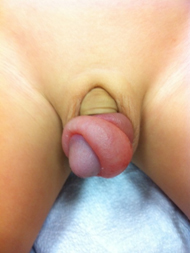Summary
Definition
History and exam
Key diagnostic factors
- presence of risk factors
- newborn and toddler age
- abnormal location of urethra
- incomplete prepuce
- penile curvature and/or torsion
- recent genital examination or procedure
- history of short or small penis
- penile pain and swelling
- foreskin adherent to glans
- penile adhesions and smegma
- penile cicatrix
- penile glans oedema
- prominent pre-pubic fat pad
- presence of hernia or hydrocele
Other diagnostic factors
- forced retraction of foreskin
- dyspareunia
- recent penile trauma
- history of balanitis or balanoposthitis
- urinary obstruction or retention
- necrosis of penile skin
- discoloration of glans
- penile length discrepancy
- history of urinary tract infection
- history of pelvic or genitourinary surgery
- erectile dysfunction
Risk factors
- uncircumcised penis (paraphimosis)
- indwelling urinary catheter (paraphimosis)
- parental unawareness (phimosis)
- balanitis xerotica obliterans (phimosis)
- penile trauma (phimosis)
- recurrent balanitis and balanoposthitis (phimosis)
- low birth weight (hypospadias)
- premature delivery (hypospadias)
- gestational diabetes, maternal obesity, maternal hypertension, older maternal age (hypospadias)
- family history (hypospadias, congenital penile curvature and/or torsion)
- obesity (buried penis)
- circumcision (trapped penis)
- penile and lower abdominal scarring (buried penis)
- hernia or hydrocoele (buried penis)
- SRD5A2 gene V89L polymorphism (hypospadias)
Diagnostic investigations
Treatment algorithm
Contributors
Authors
Kathleen Kieran, MD, MSc, MME
Director of Pediatric Urology Fellowship
Professor and Vice Chair for Equity, Diversity, and Inclusion
Department of Urology
University of Washington
Seattle
WA
Disclosures
KK declares that she has no competing interests.
Acknowledgements
Dr Kathleen Kieran would like to gratefully acknowledge Dr Nicol Corbin Bush, Dr Nicholas Cost, Dr Linda Baker, and Dr Michael Holzer, previous contributors to this topic.
Disclosures
NCB, NC, LB, and MH declare that they have no competing interests.
Peer reviewers
David Bloom, MD
Chair
Department of Urology
The Jack Lapides Professor of Urology
University of Michigan Medical School
Ann Arbor
MI
Disclosures
DB declares that he has no competing interests.
Vincent Gnanapragasam, MBBS, BMedSci, PhD, FRCSEng, FRCSEd(Urol)
Lecturer in Uro-oncology and Consultant Urological Surgeon
Department of Urology
Addenbrooke's Hospital
Cambridge
UK
Disclosures
VG declares that he has no competing interests.
Laurence Baskin, MD
Chief
Pediatric Urology
and Professor
Urology and Pediatrics
UCSF Children's Hospital
San Francisco
CA
Disclosures
LB declares that he has no competing interests.
Use of this content is subject to our disclaimer
